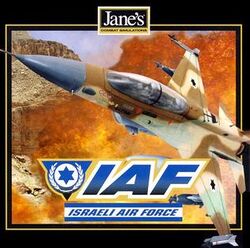Software:Jane's IAF: Israeli Air Force
| Jane's IAF: Israeli Air Force | |
|---|---|
 | |
| Developer(s) | Pixel Multimedia |
| Publisher(s) | Electronic Arts |
| Director(s) | Ramy Weitz David Zerah |
| Producer(s) | David Zerah |
| Designer(s) | Aviv Yam-Shahor |
| Programmer(s) | Benny Karov Tal Raviv Ady Shimony Shai Almog |
| Artist(s) | Edo Segal Hila Peled |
| Composer(s) | Danny Aharonson Assaf Gavron Ishai Adar |
| Series | Jane's Combat Simulations |
| Platform(s) | Microsoft Windows |
| Release | September 10, 1998 |
| Genre(s) | Combat flight simulator |
| Mode(s) | Single-player, Multiplayer |
Jane's IAF: Israeli Air Force (In Hebrew: כוכב כחול, Kochav Kachol, lit. "Blue Star") is a military jet aircraft Combat flight simulation video game released in 1998. The simulation was created by the Israeli software developer Pixel Multimedia and was released under the Jane's Combat Simulations line from Electronic Arts.
Plot
The game, which is set in the Middle East, featured a single campaign mode which included several missions and a Massively Multiplayer Online Arena. There were two type of campaigns; the first type of campaigns featured recreations of several historic operations of the Israeli Air Force such as the 1967 Six-Day War, the 1973 Yom Kippur War, and the 1982 Lebanon War. The second types of campaigns featured several fictional futuristic operations with Iraq, Syria, and Lebanon.
Gameplay
Between the years 1998 and 2002 a player of the game could log onto Jane's Combat.Net website and find other potential players to play multiplayer games against. The Multiplayer version of the game featured an "All-Out-War" mission or "Teamplay" (two teams against each other). There were also two additional aircraft which were available only in the multiplayer mode - the MiG-23 and MiG-29. The game can also be played with others over a LAN.
Critical reception
| Reception | ||||||||||||
|---|---|---|---|---|---|---|---|---|---|---|---|---|
| ||||||||||||
Robin G. Kim of Computer Gaming World said that while the game wasn't the most accurate of flight simulators, it had adequate "realism and manageable complexity".[3] Meanwhile, T. Liam McDonald of GameSpot felt it was a worthy successor to Navy Fighters and ATF.[4]
See also
References
- ↑ "Israeli Air Force for PC". CBS Interactive. Archived on 5 December 2019. Error: If you specify
|archivedate=, you must also specify|archiveurl=. https://www.gamerankings.com/pc/197657-israeli-air-force/index.html. - ↑ D'Aprile, Jason. "Israeli Air Force". PC Games. Archived from the original on September 22, 1999. https://web.archive.org/web/19990922020147/http://pcgames.com/reviews/fly_drive/fly_drive_israeli.html.
- ↑ "GameSpot presents CGW's Israeli Air Force review". 2000-12-11. Archived from the original on 2000-12-11. https://web.archive.org/web/20001211090600/http://www.gamespot.com/simulation/israelaf/review_cgw.html.
- ↑ "GameSpot: Israeli Air Force Review". 2000-12-11. Archived from the original on 2000-12-11. https://web.archive.org/web/20001211063500/http://www.gamespot.com/simulation/israelaf/review.html.
External links
 |

